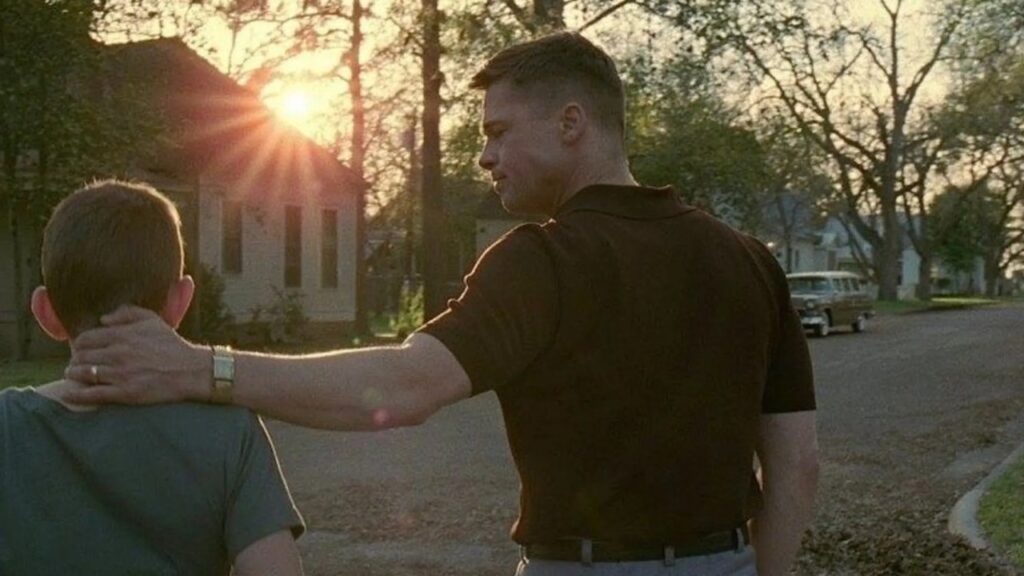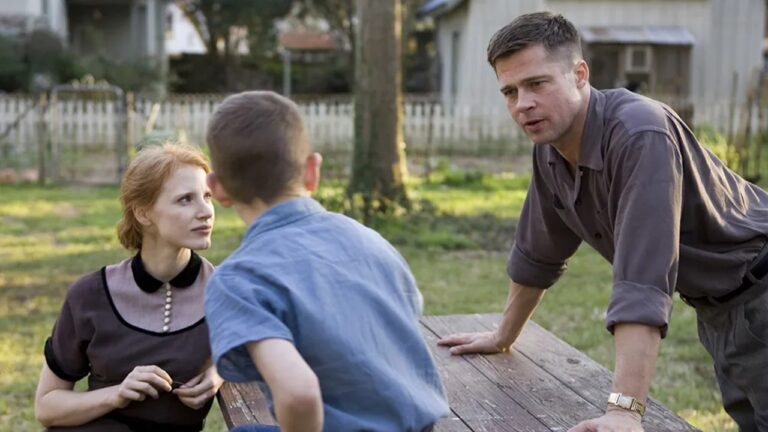Terrence Malick’s ‘The Tree of Life‘ (2011) is a film that defies conventional storytelling, creating an experience that is as much about feeling as it is about narrative. From its opening sequence, the movie establishes itself as an exploration of existence itself, blending the personal with the cosmic in a way rarely seen in modern cinema. The film begins with a visual depiction of the universe’s formation, showing stars ignite, planets collide, and primordial waters swirl. This sequence, captured with a combination of practical effects and computer-generated imagery, immediately signals the ambition of the film. Malick does not merely tell a story, as he invites the audience into a meditation on life, memory, and the interconnectedness of all things.
The heart of the film, however, is deeply intimate, as it follows Jack O’Brien, portrayed in adulthood by Sean Penn, and his memories of growing up in 1950s Waco, Texas. The childhood sequences, played by Hunter McCracken, depict a family navigating the tensions between discipline and compassion. Jack’s father, embodied by Brad Pitt, is a figure of rigor and expectation, while Jessica Chastain’s mother represents nurturing and grace. Through their interactions, Malick explores the tension between structure and love, authority and forgiveness, which is a theme that resonates throughout the film. The contrast is never didactic; it is observed in the rhythms of family life: mealtimes, play, school, and quiet domestic moments.
Jack’s Journey Through Childhood, Grief, and the Universe

What distinguishes The Tree of Life is how Malick renders memory and perception. The narrative is non-linear, moving fluidly between Jack’s childhood, his adult reflections, and cosmic imagery that spans millennia. This approach mirrors the way memory operates, which is fragmented, emotional, and associative. Scenes of Jack running through fields, swimming, and exploring nature are intercut with sequences of evolution, dinosaurs, and the formation of Earth. The result is a tapestry that situates human experience within the vastness of the universe, emphasizing both the fragility and significance of individual life.
Cinematographer Emmanuel Lubezki’s work is central to the film’s beauty. Every frame is meticulously composed, capturing natural light, shifting weather, and the textures of trees, water, and sky. The camera often moves with a fluidity that mirrors thought or breath, lingering on small gestures, whether a hand, a look, or a moment of laughter that reveals the emotional weight of everyday life. These images are complemented by a sound design and classical score that heighten the sense of wonder without overwhelming the naturalistic aesthetic. Malick’s use of silence and ambient sound allows viewers to inhabit the spaces of the film fully, experiencing both the intimacy of the O’Brien household and the immensity of the cosmos.
Loss and grief are understated yet profound in the narrative. The death of Jack’s brother, while not explicitly dramatized, casts a long shadow over the film, shaping his reflections as an adult. The tension between the father’s strictness and the mother’s gentleness becomes a lens through which Jack and the audience consider mortality, memory, and the fleeting nature of childhood. In adulthood, Jack’s reflections, voiced through Malick’s characteristic narration, do not resolve in conventional terms. Instead, they evoke the ongoing process of understanding, reconciling love and discipline, and acknowledging the permanence of both grief and grace.
The Emotional Core of The Tree of Life

The film’s climax is less a plot resolution than a visual and emotional synthesis. Jack experiences a vision of lost loved ones and childhood moments enveloped in light, suggesting a reconciliation of personal memory with a universal perspective. The closing imagery returns to cosmic sequences, now deeply tied to the intimate story, reinforcing the central notion that life is both singular and interconnected, which is a fleeting yet essential part of the universe.
The Tree of Life is a film of contrasts because it is intimate and cosmic, strict and graceful, memory and imagination. It is structured less as a traditional narrative than as a meditation on existence, and its beauty lies in the precision of its imagery, the honesty of its observations, and the emotional resonance of its small, human moments. Malick’s work here is a reminder of the power of cinema to reflect the human condition not only through story but through sight, sound, and the careful articulation of time. It is a film that lingers, not because of plot or dialogue, but because of its capacity to make the everyday sacred and the vastness of the universe personal. In The Tree of Life, cinema becomes a space where memory, love, and existence converge in quiet, enduring beauty.




